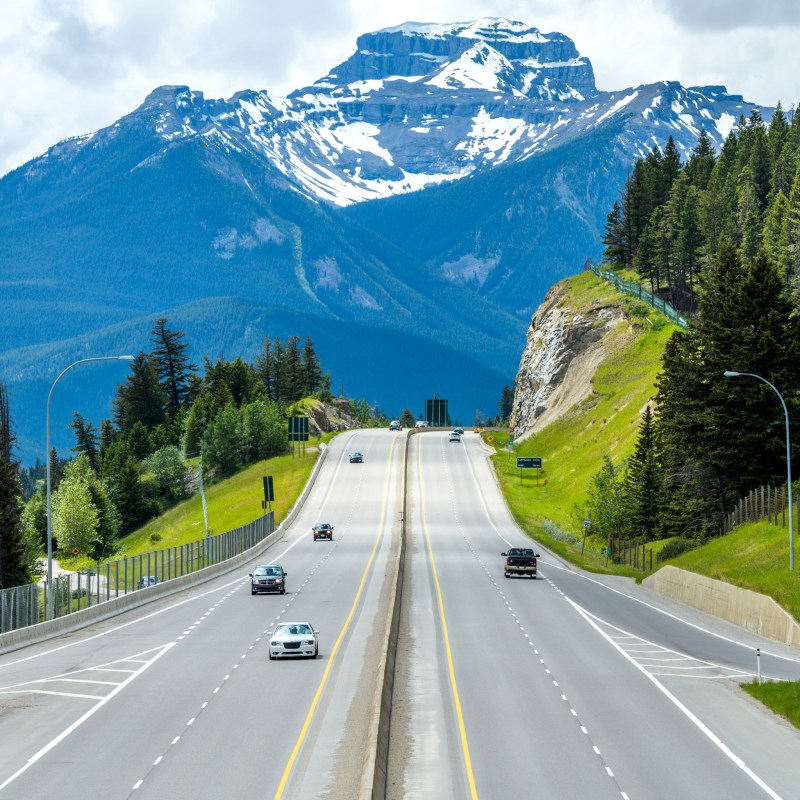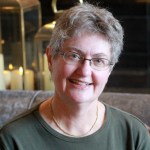
The drive from Calgary to Vancouver is 680 miles of ever-changing views, forested mountains, glaciers, sparkling rivers, and waterfalls. The wildlife ranges from friendly birds to stay-away-from-me bears. Food, drink, and accommodations are offered all along the way.
Videos by TravelAwaits
One day is too short, two is comfortable without stopping much. Two or three weeks would make for a good holiday road trip.
Summer (June through September) has the best weather. May and October are less busy and just as scenic.
This is a major route, open all year. Some stretches, notably near Rogers Pass and the Coquihalla Highway, can be closed for days in the winter for avalanche control and to wait out storms.
Traffic reports and road conditions are available online and by radio in both Alberta and British Columbia. A network of webcams covers much of the journey.
The route was made for trains; cars followed. The Canadian Pacific Railway (CP Rail) built grand hotels to attract passengers: the Palliser in Calgary, Banff Springs, Chateau Lake Louise, and Hotel Vancouver. Now they’re famous for their luxury. If you don’t stay overnight, you can still enjoy a meal or drink in opulence.

Calgary, Alberta
Calgary offers all the big-city amenities you could ask for: shopping, theater, music, professional sports, golf, fishing in the Bow River, great restaurants, craft breweries and distilleries, and a network of walking and cycling trails.
Learn about the native animals at the Calgary Zoo’s Canadian Wilds. For human history, visit Heritage Park (open seasonally), Fort Calgary, and the Glenbow Museum. The world-famous Calgary Stampede, a rodeo and festival, happens in July.

Cochrane, Alberta
Cochrane celebrates ranching history at the Bert Sheppard Stockmen’s Foundation Library and Archives. Since the 1940s, Calgarians have enjoyed MacKay’s Ice Cream. The Links of GlenEagles golf course has a million-dollar view.
Consider spending the night here to shorten your drive to Banff the next day.

Canmore, Alberta
A town obsessed with outdoor adventure, Canmore’s many choices include cross-country skiing at the Nordic Centre and scenic hiking in summer. This is a good place to gas up the car before you enter Banff National Park. Try Beamer’s Coffee Bar for coffee and snacks.

Banff National Park And Banff Town, Alberta
Banff is Canada’s oldest national park. The town of the same name overflows with shops and services in every price range.
My perfect day in Banff would start with a hike, using current information from Parks Canada to choose the best trail for the conditions. After, I’d relax in the Upper Hot Springs. Then I’d reward myself with a meal at one of the many restaurants in town.
Road tripping in the colder months? Here’s how to spend a beautiful winter day in Banff.
From Banff, the Trans-Canada Highway (TCH, also called T-Can and Highway 1) runs through two of the four national parks in the Canadian Rocky Mountain Parks UNESCO World Heritage site.

Lake Louise, Alberta
The photogenic green-blue lake cradled by mountains is right here, on the front lawn of the Fairmont Chateau Lake Louise. Hike around the lake in summer; have the ultimate ice skating experience in winter. Just be prepared for crowds and parking delays, and allow yourself lots of time if you go between June and October.
Parks Canada is working hard to make Lake Louise easier to visit. Check their Lake Louise and Moraine Lake page for up-to-date guidance.
Away from the lake, Travel Alberta’s Lake Louise Visitor Centre in Samson Mall has useful information and an interpretive center. The mall stores sell outdoor equipment, souvenirs and gifts, books, and food. Friendly grey birds, called whisky jacks or Canada jays, may come round looking for a snack.
The skiing at Lake Louise Ski Resort is world-class. In summer, the gondola will take you up the mountain.
Driving on to Golden, British Columbia, through Field, you cross the Great Divide, North America’s watershed.
The Kicking Horse River beside the highway is a textbook example of a braided river, made of many little streams flowing around the rocks.

Golden, British Columbia
Kicking Horse Pass National Historic Site marks the highest part of the TCH. The roadside pullout gives a commanding view of the Spiral Tunnels, a 19th-century engineering solution to crossing the steep mountains by train.
Farther along, the Park Bridge, which opened to car traffic in 2007, is one of Canada’s highest bridges at 300 feet above the river.
Golden has food and accommodation in the low to mid price ranges. On the hillside before the town, bighorn sheep are often seen, but how they got there is a bit of a mystery.

Rogers Pass, British Columbia
The Discovery Centre in Rogers Pass National Historic Site shows the challenges of building the railroad and highway through this high pass and the difficulty of keeping both open. Every year, the Royal Canadian Artillery’s big guns set off controlled avalanches. The snowsheds along the road shelter vehicles from snowslides.

Revelstoke, British Columbia
Revelstoke is the perfect place for outdoor adventure. Rafters, skiers, boarders, mountain bikers, and climbers all find fun here. It’s a great stopping place for railway buffs and a good overnight break before the two- or three-day drive to Vancouver. I enjoy the quiet Giant Cedars Boardwalk hike through old-growth forest.
Down the road at Craigellachie, one of Canada’s big moments — the driving of the Last Spike of the CPR — happened in 1885. There’s a comfortable stop here with restrooms and outdoor interpretive displays.
Around this point in the road trip, the landscape slowly changes from tall, pointy mountains, narrow valleys, and high passes to broad open spaces, dry slopes, and farmland. Between the Rockies and their associated ranges and the Coast Mountains are the Central Plateaux, which are high and fairly dry.

Sicamous, British Columbia
Sicamous is the houseboat capital of the west. People rent boats by the week to enjoy the Shuswap Lakes.
One variation on the route to Vancouver is to head south from here to Vernon and the Okanagan Valley, sampling the wines and enjoying the lakeside resorts at Kelowna and Penticton.

Kamloops, British Columbia
Kamloops is one of the larger places on the route (with a population of about 90,000) and is well placed to offer an interesting selection of local food and drink. On a two-day drive, this is where I usually stay the night, choosing a chain hotel on the highway.
The route now follows the Coquihalla Highway (Highway 5) south.
Another option is to take Highway 1 (TCH) west to Cache Creek. From there, you can take the TCH south via Yale to Hope or Highway 99 west to Whistler, reaching Vancouver from the northwest.
The Coquihalla is the shortest way and very scenic. In bad weather, though, one of the other routes may be easier.

Hope, British Columbia
Nearing the bottom of the Coquihalla Pass, names from Shakespeare show up on the road signs, thanks to the fancy of railroad engineer Andrew McCulloch a hundred years ago. The Othello Tunnels turnoff leads to Coquihalla Canyon Provincial Park and a flat hike through McCulloch’s tunnels.
At Hope, the mountains end. I often eat at Rolly’s Restaurant and stroll to the Fraser River. Hope even has an unexpected connection with Rambo, which was filmed there in the early ’80s.

Harrison Hot Springs, British Columbia
Vancouverites love Harrison Hot Springs, a family resort on a long lake. Like Banff, the pools are fed by natural mineral springs. I’ve enjoyed delicious meals in the hotel.

Vancouver
Vancouver has a warm ocean on its doorstep and mountains behind. Skiing? No problem. Golf? Of course. On the same day? Maybe!
Stanley Park must be Vancouver’s best-known attraction, a vast forest with totem poles, trails, giant trees, and the Vancouver Aquarium. Then there’s the Vancouver Art Gallery, funky Gastown, the Museum of Anthropology at the University of British Columbia, the beaches, and VanDusen Gardens.
Vancouver has many inventive chefs and foodies who appreciate them. Asian food is mainstream here. Granville Island Public Market has fresh produce, fish, and specialty foods. The Pacific Institute of Culinary Arts next door offers tours, classes, and meals.
To leave the car behind and explore the city center, use the SkyTrain. It connects to the airport and some of the outer suburbs. Time for bed? Vancouver has a full range of hotel options.
Pro Tips
- Park Pass: You need a pass to stop in any of the national parks, even for 10 minutes.
- Safety: In any season, be ready for winter weather in the mountains.
- Animals: Wild animals live along most of this route. You have a good chance of seeing deer, elk, mountain sheep, and coyotes. With luck, you may also see mountain goats and a bear. Experts recommend you stay in your vehicle. This is for the animals’ safety and comfort and yours. To be even better prepared, read up on our tips for safely viewing wildlife in national parks before you go.
- Food and Accommodation: The towns listed have affordable and mid-range accommodation and a variety of restaurants and fast-food places. For luxury, choose to stay and dine in Calgary, Banff, Lake Louise, and Vancouver.
- Camping and RVing: Camping and RVing in the national parks during the summer is very popular and usually requires advance reservations.
